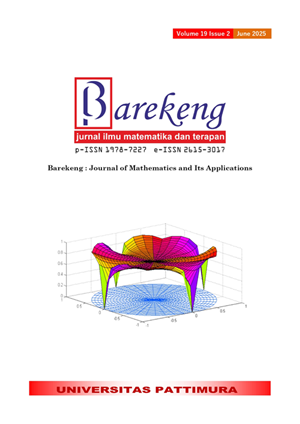STABILITY ANALYSIS AND PERFORMANCE OF KALMAN FILTERING AND ROBUST KALMAN FILTERING ON UNCERTAIN CONTINUOUS-TIME SYSTEMS
Abstract
This paper discusses the stability analysis of robust Kalman filtering on uncertain continuous-time systems. In real applications, systems often face model uncertainty and noise affecting prediction and estimation accuracy. Therefore, a filtering method is needed to overcome these uncertainties. Robust Kalman filtering is one of the most effective methods for dealing with model uncertainty. In this paper, we discuss the application of this method to continuous-time systems and its stability analysis. Simulation results show that robust Kalman filtering can provide more accurate and stable estimates than the conventional Kalman filter. Robust Kalman filtering can reduce the estimation error to about 30% under uncertain model conditions and maintain stability despite disturbances of up to 20% of the system parameters. However, this research has limitations regarding testing scenarios with more complex uncertainty models and higher disturbance variability. The originality of this research lies in its focus on the stability analysis of robust Kalman filtering on uncertain continuous-time systems, which has rarely been discussed in depth in previous literature.
Downloads
References
N. Chukhrova and A. Johannssen, “KALMAN FILTER LEARNING ALGORITHMS AND STATE SPACE REPRESENTATIONS FOR STOCHASTIC CLAIMS RESERVING,” Risks, vol. 9, no. 6, 2021, doi: 10.3390/risks9060112.
T. Han, F. N. B. Gois, R. Oliveira, L. R. Prates, and M. M. de A. Porto, “MODELING THE PROGRESSION OF COVID-19 DEATHS USING KALMAN FILTER AND AUTOML,” Soft Comput., vol. 27, no. 6, 2023, doi: 10.1007/s00500-020-05503-5.
N. Hao, F. He, C. Tian, Y. Yao, and W. Xia, “KD-EKF: A CONSISTENT COOPERATIVE LOCALIZATION ESTIMATOR BASED ON KALMAN DECOMPOSITION,” IEEE Int. Conf. Intell. Robot. Syst., no. Cl, pp. 11064–11070, 2023, doi: 10.1109/IROS55552.2023.10341604.
S. Afshar, F. Germ, and K. A. Morris, “EXTENDED KALMAN FILTER BASED OBSERVER DESIGN FOR SEMILINEAR INFINITE-DIMENSIONAL SYSTEMS,” pp. 1–20, 2022, [Online]. Available: http://arxiv.org/abs/2202.07797
I. Ullah, S. Qian, Z. Deng, and J. H. Lee, “EXTENDED KALMAN FILTER-BASED LOCALIZATION ALGORITHM BY EDGE COMPUTING IN WIRELESS SENSOR NETWORKS,” Digit. Commun. Networks, vol. 7, no. 2, 2021, doi: 10.1016/j.dcan.2020.08.002.
A. Daid, E. Busvelle, and M. Aidene, “ON THE CONVERGENCE OF THE UNSCENTED KALMAN FILTER,” Eur. J. Control, vol. 57, 2021, doi: 10.1016/j.ejcon.2020.05.003.
A. Tuveri, F. Pérez-García, P. A. Lira-Parada, L. Imsland, and N. Bar, “SENSOR FUSION BASED ON EXTENDED AND UNSCENTED KALMAN FILTER FOR BIOPROCESS MONITORING,” J. Process Control, vol. 106, 2021, doi: 10.1016/j.jprocont.2021.09.005.
S. Kim, V. M. Deshpande, and R. Bhattacharya, “ROBUST KALMAN FILTERING WITH PROBABILISTIC UNCERTAINTY IN SYSTEM PARAMETERS,” IEEE Control Syst. Lett., vol. 5, no. 1, pp. 295–300, 2021, doi: 10.1109/LCSYS.2020.3001490.
J. Saha and S. Bhaumik, “ROBUST MAXIMUM CORRENTROPY KALMAN FILTER,” 2023, [Online]. Available: http://arxiv.org/abs/2302.02694
M. Dutta, B. Timande, and R. Mandal, “ROBUST KALMAN FILTERING FOR LINEAR DISCRETE TIME UNCERTAIN SYSTEMS,” Int. J. Adv. Eng. Technol., vol. 4, no. 2, pp. 276–283, 2012.
G. Agamennoni, J. I. Nieto, and E. M. Nebot, “AN OUTLIER-ROBUST KALMAN FILTER,” Proc. - IEEE Int. Conf. Robot. Autom., no. February 2014, pp. 1551–1558, 2011, doi: 10.1109/ICRA.2011.5979605.
A. Rauh and J. Kersten, “TRANSFORMATION OF UNCERTAIN LINEAR SYSTEMS WITH REAL EIGENVALUES INTO COOPERATIVE FORM: THE CASE OF CONSTANT AND TIME-VARYING BOUNDED PARAMETERS,” Algorithms, vol. 14, no. 3, 2021, doi: 10.3390/a14030085.
S. luo Guo, Y. jie Sun, L. min Chang, and Y. Li, “ROBUST CUBATURE KALMAN FILTER METHOD FOR THE NONLINEAR ALIGNMENT OF SINS,” Def. Technol., vol. 17, no. 2, pp. 593–598, 2021, doi: 10.1016/j.dt.2020.03.016.
X. Zhang, Z. Yan, and Y. Chen, “HIGH-DEGREE CUBATURE KALMAN FILTER FOR NONLINEAR STATE ESTIMATION WITH MISSING MEASUREMENTS,” Asian J. Control, vol. 24, no. 3, 2022, doi: 10.1002/asjc.2510.
H. Wang, Y. Dong, and M. Deng, “FINITE-TIME BOUNDEDNESS ANALYSIS FOR A CLASS OF UNCERTAIN DISCRETE-TIME SYSTEMS WITH INTERVAL TIME-VARYING DELAY,” WSEAS Trans. Syst., vol. 18, pp. 85–92, 2019.
T. Dong, P. Zhang, and F. Liang, “A STOCHASTIC APPROXIMATION-LANGEVINIZED ENSEMBLE KALMAN FILTER ALGORITHM FOR STATE SPACE MODELS WITH UNKNOWN PARAMETERS,” J. Comput. Graph. Stat., vol. 32, no. 2, pp. 448–469, 2023, doi: 10.1080/10618600.2022.2107531.
S. Bahri, H. R. Riyandi, and B. Rudianto, “STABILITY OF THE DYNAMIC MODEL OF SVPR SEXUAL VIOLENCE CASES,” BAREKENG J. Ilmu Mat. dan Terap., vol. 18, no. 3, pp. 1719–1728, 2024, doi: 10.30598/barekengvol18iss3pp1719-1728.
A. S. Haning Puspita, S. Sutrima, R. Setiyowati, and S. Wibowo, “STABILITY ANALYSIS OF CELLULAR OPERATING SYSTEM MARKET SHARE IN INDONESIA WITH THE COMPETITIVE LOTKA-VOLTERRA MODEL,” BAREKENG J. Ilmu Mat. dan Terap., vol. 18, no. 1, pp. 0333–0340, 2024, doi: 10.30598/barekengvol18iss1pp0333-0340.
S. C. Brenner, S. Liu, and L. Sung, “MULTIGRID METHODS FOR SADDLE POINT PROBLEMS: KARUSH-KUHN-TUCKER SYSTEMS,” 2018, [Online]. Available: http://arxiv.org/abs/1811.12434
B. Liu, “UNCERTAIN SET THEORY AND UNCERTAIN INFERENCE RULE WITH APPLICATION TO UNCERTAIN CONTROL,” Online, vol. 4, no. 2, pp. 83–98, 2010.
G. P. Meyer, “AN ALTERNATIVE PROBABILISTIC INTERPRETATION OF THE HUBER LOSS,” Proc. IEEE Comput. Soc. Conf. Comput. Vis. Pattern Recognit., no. Section 2, pp. 5257–5265, 2021, doi: 10.1109/CVPR46437.2021.00522.
A. H. Mary, A. H. Miry, and M. H. Miry, “SYSTEM UNCERTAINTIES ESTIMATION BASED ADAPTIVE ROBUST BACKSTEPPING CONTROL FOR DC DC BUCK CONVERTER,” Int. J. Electr. Comput. Eng., vol. 11, no. 1, pp. 347–355, 2021, doi: 10.11591/ijece.v11i1.pp347-355.
Z. Wang, X. Hou, Z. Dan, and K. Fang, “ADAPTIVE KALMAN FILTER BASED ON INTEGER AMBIGUITY VALIDATION IN MOVING BASE RTK,” GPS Solut., vol. 27, no. 1, pp. 1–15, 2023, doi: 10.1007/s10291-022-01367-4.
Copyright (c) 2025 Budi Rudianto, Muhafzan Muhafzan, Mahdhivan Syafwan, Syafrizal Sy

This work is licensed under a Creative Commons Attribution-ShareAlike 4.0 International License.
Authors who publish with this Journal agree to the following terms:
- Author retain copyright and grant the journal right of first publication with the work simultaneously licensed under a creative commons attribution license that allow others to share the work within an acknowledgement of the work’s authorship and initial publication of this journal.
- Authors are able to enter into separate, additional contractual arrangement for the non-exclusive distribution of the journal’s published version of the work (e.g. acknowledgement of its initial publication in this journal).
- Authors are permitted and encouraged to post their work online (e.g. in institutional repositories or on their websites) prior to and during the submission process, as it can lead to productive exchanges, as well as earlier and greater citation of published works.






1.gif)



